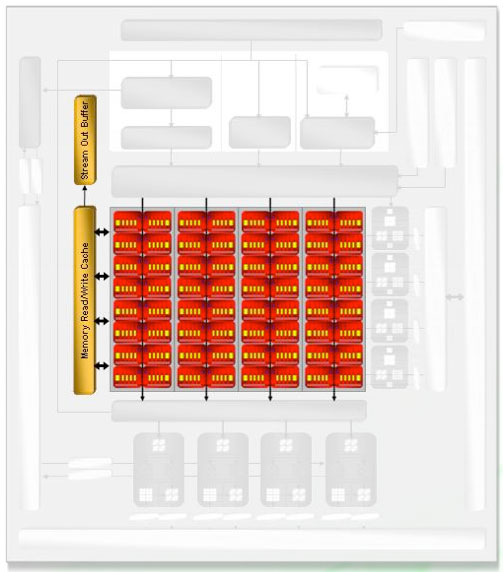ATI Radeon HD 2900 XT: Calling a Spade a Spade
by Derek Wilson on May 14, 2007 12:04 PM EST- Posted in
- GPUs
Finally: A Design House Talks Cache Size
We're quite used to talking about cache sizes on Intel and AMD CPUs, but graphics hardware has been another story. We've been asking for quite some time, while other sites have taken to writing shader code to come up with educated guesses about how much data fits on die. Today we are very happy to bring you everything you could ever want to know about R600 caches.
The four texture units are connected to memory through two levels of cache. Unfiltered texture requests go through the Vertex Cache (which is unfiltered) and filtered requests make use of the L1 Texture Cache. Each of these caches is 32kB read only. All texture units share these caches.

Both the L1 Texture Cache and the Vertex Cache are connected to an L2 cache that is 256kB. This is the largest cache on the chip, and will certainly handle quite a bit of data movement with the possibility of 8k x 8k texture sizes moving forward.
As for the shader hardware, the cache connected to the SIMD units is an 8 kB read / write cache. This cache is used to virtualize register space if necessary, export data to the stream out buffer (which can be done from any type of thread and can bypass the need to send data to the render back ends). This cache is also used to accelerate things like render to vertex buffer.

Most of R600's write caches are write-back caches, although we weren't given any specifics on which write caches are not write-back. The impression is that any unit that needs to write out over the memory bus is connected through a write cache that enables write combining to maximize bus utilization, write latency hiding, and short term reuse. We assume that the shader cache (what AMD calls the Memory Read/Write Cache) is also write-back.
The only thing we are really missing regarding caches is the information for Z/stencil cache and color cache connected off of the render back ends.










86 Comments
View All Comments
Roy2001 - Tuesday, May 15, 2007 - link
The reason is, you have to pay extra $ for a power supply. No, most probably your old PSU won't have enough milk for this baby. I will stick with nVidia in future. My 2 cents.Chaser - Tuesday, May 15, 2007 - link
Such a revealing tech article. Thanks for other sources Tom.
archcommus - Tuesday, May 15, 2007 - link
$300 is the exact price point I shoot for when buying a video card, so that pretty much eliminates AMD right off the bat for me right now. I want to spend more than $200 but $400 is too much. I'm sure they'll fill this void eventually, and how that card will stack up against an 8800 GTS 320 MB is what I'm interested in.H4n53n - Tuesday, May 15, 2007 - link
Interesting enough in some other websites it wins from 8800 gtx in most games,especially the newer ones and comparing the price i would say it's a good deal?I think it's just driver problems,ati has been known for not having a very good driver compared to nvidia but when they fixed it then it'll windragonsqrrl - Thursday, August 25, 2011 - link
lol...fail. In retrospect it's really easy to pick out the EPIC ATI fanboys now.Affectionate-Bed-980 - Tuesday, May 15, 2007 - link
I skimmed this article because I have a final. ATI can't hold a candle to NV at the moment it seems. Now while the 2900XT might have good value, I am correct in saying that ATI has lost the performance crown by a buttload (not even like X1800 vs 7800) but like they're totally slaughtered right?Now I won't go and comment about how the 2900 stacks up against competition in the same price range, but it seems that GTSes can be acquired for cheap.
Did ATI flop big here?
vailr - Monday, May 14, 2007 - link
I'd rather use a mid-range older card that "only" uses ~100 Watts (or less) than pay ~$400 for a card that requires 300 Watts to run. Doesn't AMD care about "Global Warming"?Al Gore would be amazed, alarmed, and astounded !!
Deusfaux - Monday, May 14, 2007 - link
No they dont and that's why the 2600 and 2400 don't existochentay4 - Monday, May 14, 2007 - link
Let me start with this: i always had a nvidia card. ALWAYS.Faster is NOT ALWAYS better. For the most part this is true, for me, it was. One year ago I boght a MSI7600GT. Seemed the best bang for the buck. Since I bought it, I had problems with TVout detection, TVout wrong aspect ratios, broken LCD scaling, lot of game problems, inexistent support (nv forum is a joke) and UNIFIED DRIVER ARQUITECTURE. What a terrible lie! The latest official drivers is 6 months ago!!!
Im really demanding, but i payed enough to demand a 100% working product. Now ATi latest offering has: AVIVO, FULL VIDEO ACC, MONTHLY DRIVER UPDATES, ALL BUGS I NOTICED WITH NVIDIA CARD FIXED, HDMI AND PRICE. I prefer that than a simple product, specially for the money they cost!
I will never buy a nvidia card again. I'm definitely looking forward ATis offering (after the joke that is/was 8600GT/GTS).
Enough rant.
Am I wrong?
Roy2001 - Tuesday, May 15, 2007 - link
Yeah, you are wrong. Spend $400 on a 2900XT and then $150 on a PSU.